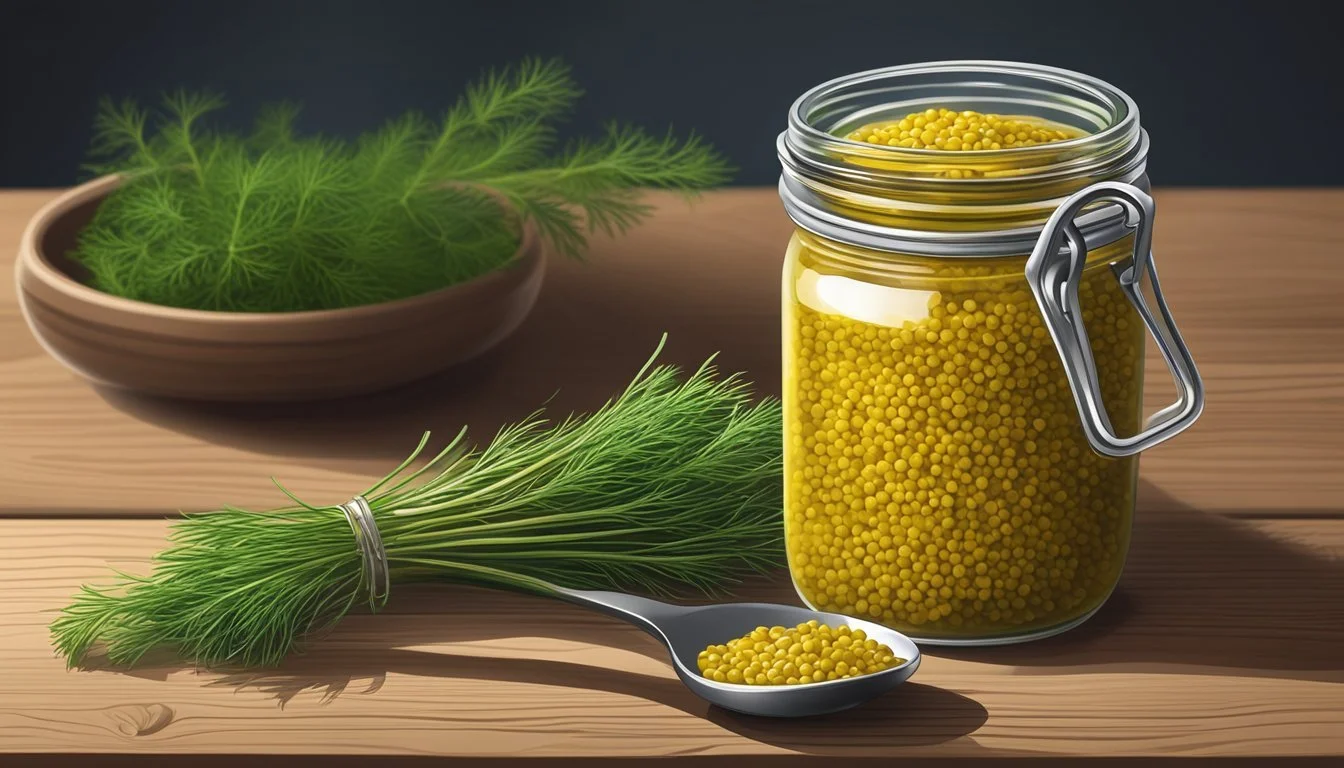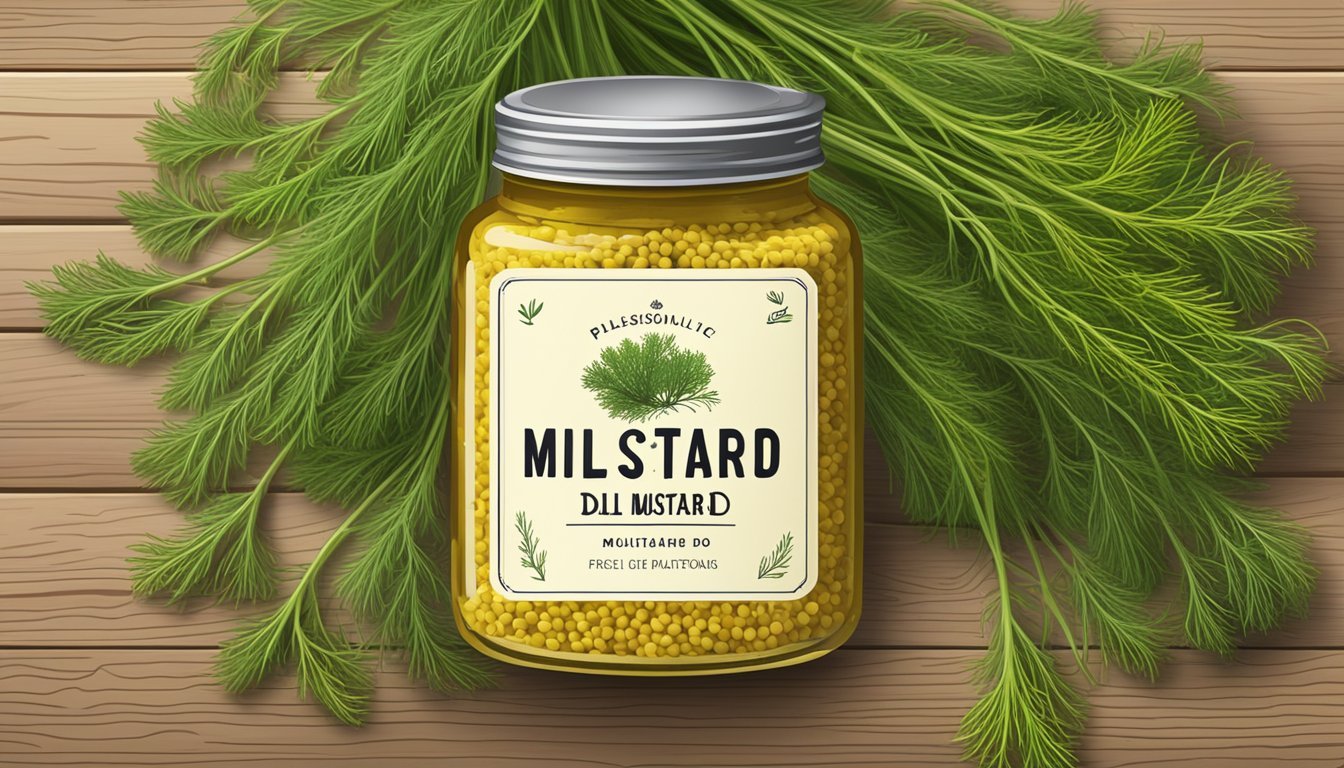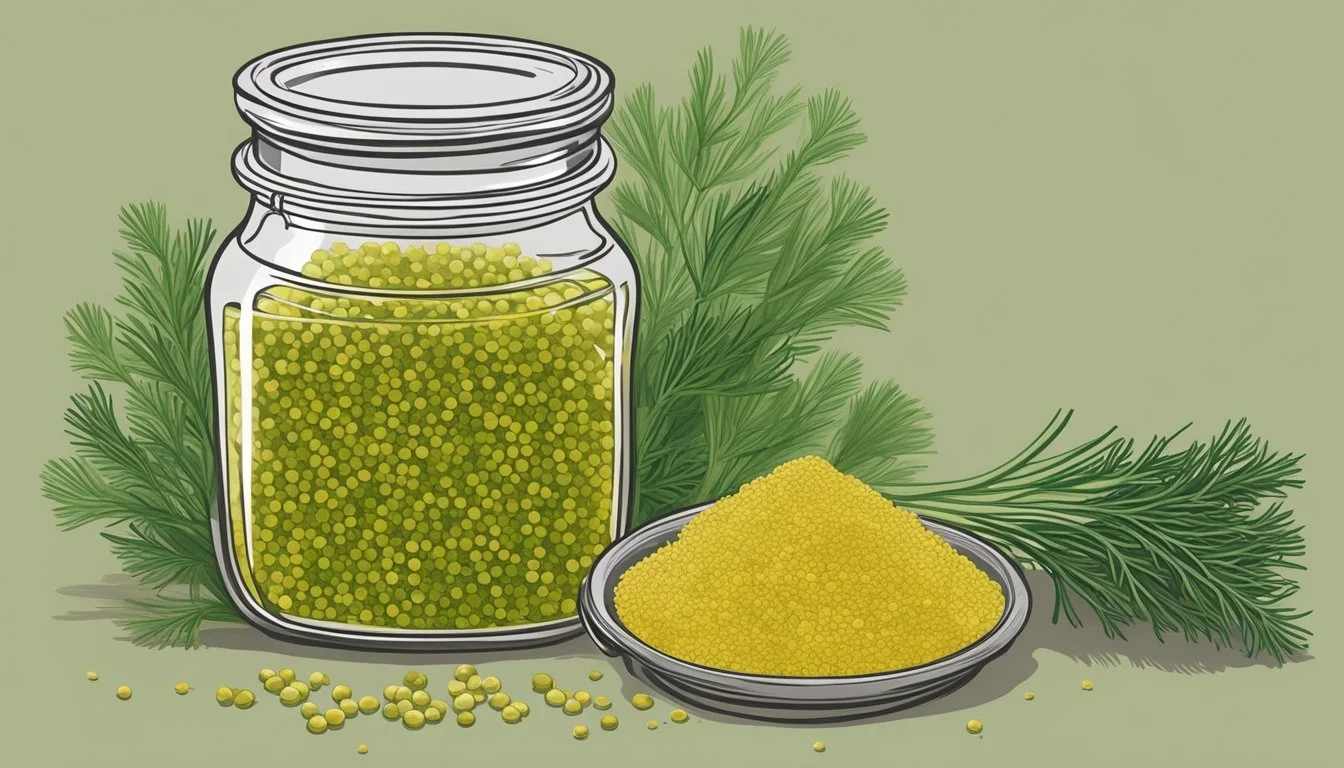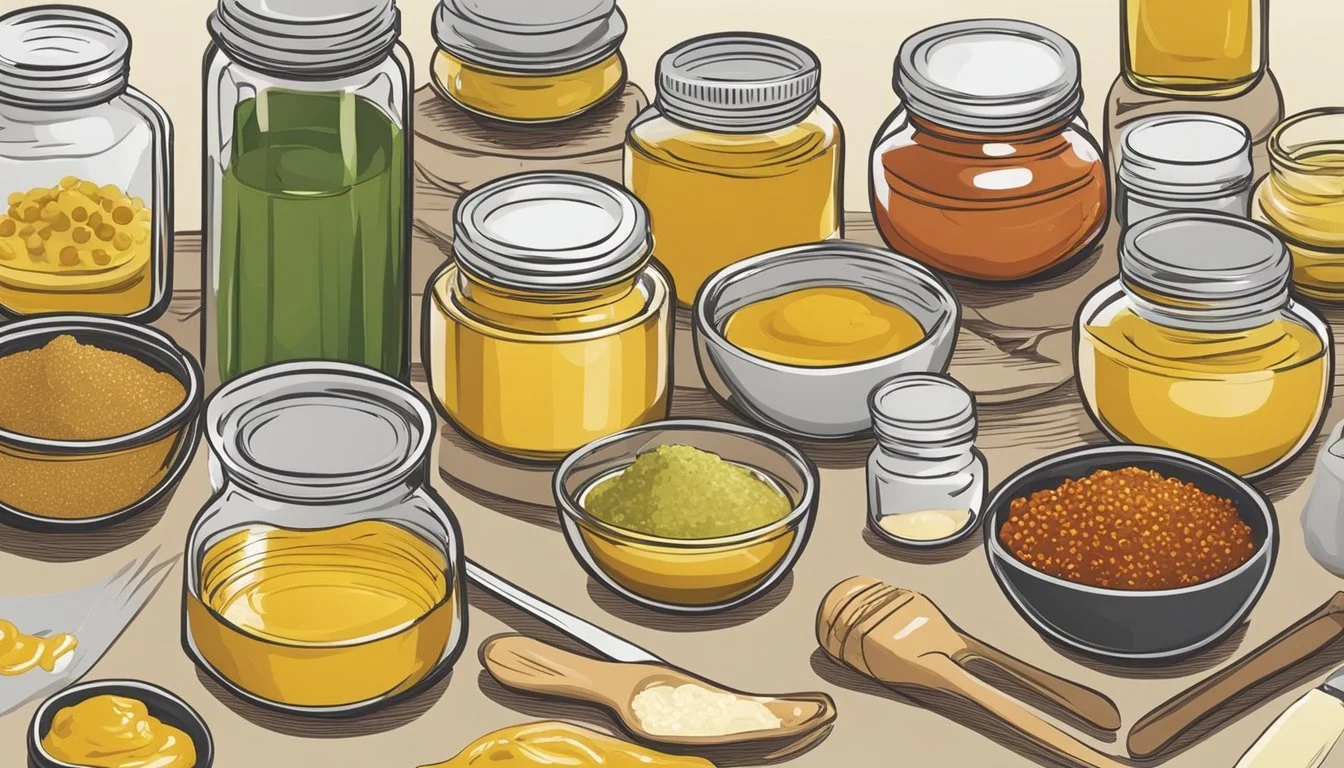Dill Mustard Substitutes
Top Alternatives for Your Recipes
When it comes to enhancing dishes with a tangy, herby flavor, dill mustard is a condiment that many chefs and home cooks reach for. Its unique taste comes from a combination of the zesty kick of mustard and the fresh, slightly anise-like flavor of dill. While it is a specialty item in many kitchens, there are times when dill mustard might not be on hand or when someone may need to avoid it due to dietary restrictions or personal taste preferences.
In such cases, substitutes must be found that can mimic or replace the distinct qualities of dill mustard in cooking. The task requires a creative approach to balance the tanginess of mustard with the particular herby notes of dill. Ingredients that are often available in a typical pantry, such as different types of mustards, herbs, and mayonnaise, can serve as stand-ins. Proper substitution not only ensures the integrity of the flavors in a recipe but also maintains the desired texture and appearance of the dish.
When searching for a dill substitute, options include using other fresh herbs such as fennel or tarragon, which offer a similar aromatic quality. In recipes calling specifically for dill mustard, stone ground or yellow mustard can be a straightforward swap. Stone ground mustard maintains the coarser texture, while yellow mustard provides a milder baseline for adding herbs. For those who enjoy a bit more zest, prepared horseradish or a small touch of wasabi can bring the necessary heat, and when mixed with mayonnaise, they contribute creaminess along with the bite. It is essential, however, to consider the unique contributions of each substitute to ensure the final dish is harmonious in flavor.
Understanding Dill and Its Role in Cooking
Dill is a versatile herb that notably enhances the flavor profile of various dishes with its distinct aromatic qualities. Essential to many cuisines, it imparts a characteristic taste that can be recognized in anything from salads to soups.
Culinary Uses of Dill
In cooking, dill is commonly known in two forms: dill weed, which are the feathery green leaves, and dill seed, used as a spice. The leaves, or fresh dill, are delicate and add a fresh, citrus-like flavor to dishes. They're a staple in:
Salads: lending a vibrant note.
Soups: contributing a slight sharpness.
Fish preparations: offering a complementary taste.
Sausages and pickles: adding depth to the flavor.
Dill's presence is integral to Scandinavian and Eastern European cuisines, where it is used liberally to season gravlax (cured salmon), borscht (beet soup), and various pickled vegetables.
Characteristics of Dill Flavor
Dill's taste profile is unique:
Flavor: It possesses a mild grassy flavor with hints of anise and lemon.
Aroma: The leaves are highly aromatic, which intensifies when the herb is heated.
Distinct flavor: Although not overpowering, dill has a distinct flavor that can dominate if overused.
Cooking with dill is a balancing act, as its leaves can easily overpower other flavors. Chefs use it to introduce a fresh dill flavor that is especially complementary in dishes featuring creamy sauces or robust seasonings.
Choosing Dill Substitutes
When seeking a dill substitute, one should consider the flavor profiles and cooking application to ensure the herb's essence is duly replicated.
Best Substitutes for Fresh Dill
Parsley: While milder, parsley can provide a fresh, green note in dishes. Generally, one tablespoon of fresh dill can be replaced with one tablespoon of fresh parsley.
Fresh Tarragon: Boasting a similar anise-like flavor, fresh tarragon can be substituted in a one-to-one ratio for fresh dill.
Fennel Fronds: With a sweet, anise-like taste, fennel fronds are excellent for mimicking dill's unique flavor in salads and seafood. Use a similar quantity to dill for best results.
When to Use Dried Dill
Dried Dill: When the fresh version is unavailable, dried dill can work. Typically, one teaspoon of dried dill equates to one tablespoon of its fresh counterpart, due to the more concentrated flavor of the dried version.
Substitution Measurements: When using dried herbs, a standard guideline is 1 teaspoon of dried for every 1 tablespoon of fresh. This ratio should be maintained to preserve desired flavor profiles in recipes calling for dill.
Alternative Herbs as Dill Substitutes
In the absence of dill, several other herbs can provide complementary flavors and textures in recipes. While no herb perfectly replicates dill's unique taste, the following alternatives offer their own distinctive characteristics that can enhance a dish.
Using Tarragon for a Similar Aroma
Tarragon, with its slight anise flavor, is a robust substitute for dill. Its aroma is reminiscent of dill's licorice-like hint, making it suitable for fish and salad dressings. The rule of thumb is to substitute in equal amounts whether using fresh or dried tarragon.
Substituting with Parsley for a Mild Flavor
Parsley, whether one opts for curly or flat-leaf, delivers a milder flavor than dill and lacks dill's citrus notes. However, it can effectively mimic dill's fresh and crisp texture. It's particularly versatile, suitable for garnishing dishes thanks to curly parsley's frilly texture, or for cooking with flat-leaf parsley's more robust flavor.
Parsley Usage Curly Ideal for garnishes Flat-leaf Preferred for its fuller flavor
The Role of Basil and Oregano
Basil and oregano stand out as dill substitutes with their own distinct profiles. Basil presents a sweet and slightly peppery flavor which is perfect for Mediterranean dishes. On the other hand, oregano provides a more assertive and earthy flavor. When substituting for dill:
Use basil sparingly, as its sweet flavor is more potent.
Oregano should be employed judiciously, especially if using the dried form, due to its intensity compared to the milder dill.
Herb Flavor Profile Best Used In Basil Sweet and peppery Mediterranean dishes Oregano Assertive and earthy Italian and Greek cooking
While not discussed in the subsections, other herbs like thyme, rosemary, and cilantro can also substitute for dill in terms of flavor or texture. For instance, cilantro can provide a bright touch in dishes where dill is unavailable, whereas rosemary's piney aroma might be desirable in heartier meals.
Specialty Substitutes for Specific Dishes
Selecting the right herb or spice can elevate the flavor profile of various dishes while accommodating for the absence of dill mustard. This section explores tailored substitutes for seafood and fish dishes, soups and stews (What wine goes well with stews?), and dressings, marinades, and sauces.
Seafood and Fish Dishes
For seafood and fish dishes that typically include dill mustard, fresh fennel serves as an excellent replacement. Its subtle aniseed flavor complements the delicate nature of fish. When making potato salad with a seafood twist or a tzatziki sauce to be served with fish, try using fresh fennel as a garnish or flavor enhancer.
Enhancing Soups and Stews
Soups and stews gain depth from herbs that withstand long cooking times. Bay leaves and caraway seeds can be used to impart a complex flavor to such dishes. When dill mustard is unavailable:
Bay Leaves: Use one bay leaf to simulate the savory depth in hearty stews.
Caraway Seeds: Add ½ teaspoon to a pot of soup to bring a warm, earthy taste.
Dressings, Marinades, and Sauces
Dill mustard often finds its place in dressings, marinades, and sauces to add a punch of flavor. In its absence, celery seeds become a reliable substitute, offering a grassy and slightly bitter quality. They blend particularly well in salad dressings where the dill flavor was intended. Start with a pinch of celery seeds and adjust to taste, ensuring balance in the overall flavor of the marinades and sauces.
Non-Herb Dill Substitutes
When the feathery green leaves of dill are not at hand, certain non-herb alternatives can mimic the distinctive taste of dill in recipes. These substitutes provide a way to impart some of the citrusy and spicy notes associated with dill.
Citrus Zests and Spices
Citrus zests, such as lemon or orange, can provide a citrusy profile that partially emulates the light, refreshing taste dill is known for. A hint of lemon zest can brighten dishes similarly to dill with its aromatic, tangy flavor. For a more anise-like sweetness that resembles dill seed, spices like fennel and anise can be used to achieve the characteristic flavor of dill without the herb itself. These spices share a similar licorice taste and are available in both seed and ground forms.
Recommended Ratios for Citrus Zests:
Lemon zest: 1 teaspoon for each tablespoon of dill
Orange zest: 1/2 teaspoon for each tablespoon of dill
Recommended Ratios for Spices:
Fennel seeds: use in equal measure to dill seeds
Ground anise: start with a pinch and adjust for taste
Seed-Based Alternatives
For recipes that call specifically for dill seeds, one can find an adequate replacement in coriander seeds. Coriander seeds offer a warm, peppery taste that can provide the spice aspect of dill seeds, making them suitable for bread, pickles, and stews. It is important to note, though, that coriander seeds do not impart the same aromatic nature as dill's feathery green leaves, but rather focus on the spicy, earthy element of the herb's flavor profile.
Recommended Ratios for Seed-Based Alternatives:
Coriander seeds: 1 teaspoon for every teaspoon of dill seeds
By carefully selecting from these non-herb substitutes, one can reproduce the taste of dill in various culinary applications with confidence.
Factors to Consider When Substituting
When substituting dill mustard in recipes, it is important to consider the flavor profile and how the alternative ingredient's taste and form, whether fresh or dried, will affect the dish. Furthermore, the substitute's availability and the potential for dietary restrictions or allergies should be weighed.
Availability and Seasonality
Freshness: Fresh substitutes may offer a more vibrant flavor but can be subject to seasonal availability. Fresh dill, for example, has a sweet taste and may be harder to find off-season.
Dried alternatives: Dried substitutes such as dill seed or dried herbs are generally available year-round. They can provide a more concentrated, earthy flavor, although they might lack the freshness of their green counterparts.
Dietary Restrictions and Allergies
Allergens: Always consider potential allergic reactions when selecting a substitute. Mustard seeds, for instance, are a common allergen and not suitable for everyone.
Dietary Needs: Ingredients should comply with dietary restrictions of those consuming the dish. For instance, those on sodium-restricted diets may require a substitute with a lower salt content.
Select substitutes that align with the original ingredient’s profile to maintain the intended flavor of the recipe while catering to these considerations.
Conclusion
When the distinctive tang of dill mustard is called for, one has several adept alternatives at their disposal. These alternatives are more than mere stand-ins; they can offer their own benefits and unique qualities to a recipe. One may confidently turn to white vinegar to provide the necessary acidity. If a herbaceous touch is desired, a chef can consider parsley for its fresh and subtly peppery profile, ideal for garnishing and imbuing dishes with a bright flavor.
Substitute Key Quality Best Uses White Vinegar Acidity Dressings, Marinades Parsley Fresh, Peppery Flavor Garnishing, Salads
The dill plant itself is familiar for its verdant, feathery fronds and a note of citrus, which is why lemon juice is another potential addition, contributing both zest and a boost of vitamin C. Furthermore, replacing dill with bay leaves in heated dishes is a wise choice, as they release their best flavors through simmering.
Crafting a well-rounded dish hinges on understanding how each ingredient interplays with others, making an informed choice vital. Whether one seeks a vinegar-based sharpness or the peppery zing of parsley, there's an option to suit any culinary circumstance. It is always wise to add these substitutes in a step-wise fashion, tasting along the way to achieve a balanced outcome. Through careful selection and tasting, a cook ensures the spirit of dill mustard is preserved, even when the real thing is out of reach.







